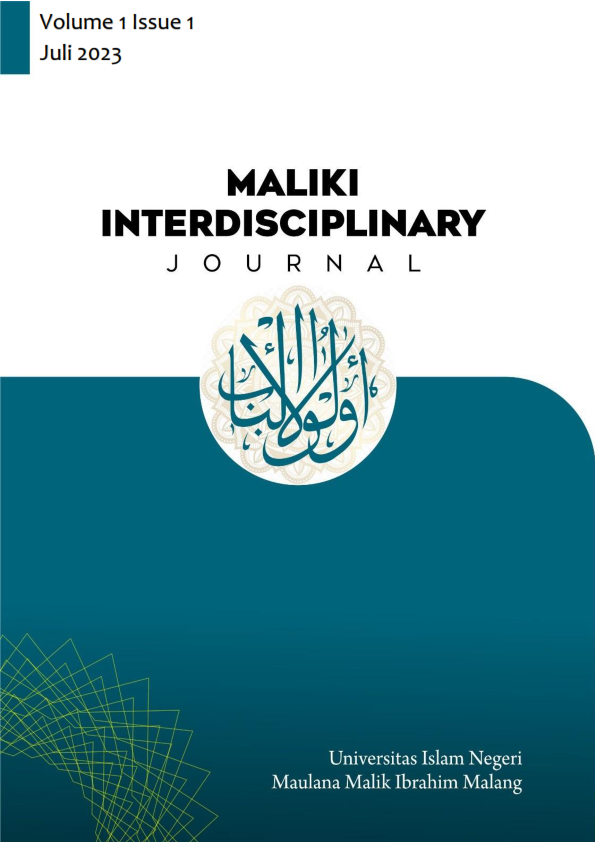Conjunctions in students’ argumentative essay of english language teaching departments of Universitas Islam Negeri Maulana Malik Ibrahim Malang
Abstract
The conjunction is part of the grammar used for a phrase or word clause in a sentence. The conjunctions represent the type of general connection readers know between sentences and conjunctions as a means of making text. The conjunctions have types, functions and errors that are used to write text. Therefore, this study aims to analyze the conjunction, specifically the types of conjunctions, functions of conjunction, and the errors of conjunction found in argumentative essays by students UIN Maulana Malik Ibrahim Malang in English Language Education. The researcher can conclude the types of conjunctions they mostly used in writing essays. Furthermore, the researcher used a qualitative descriptive approach because the data collected was in the form of essays written by students of UIN Maulana Malik Ibrahim Malang. In collecting data, researchers identify the conjunctions by giving underscores, making a list of the conjunctions that appear in the essay, and classifying each conjunction consisting of types, functions, and errors in using conjunctions. After analyzing the data, the authors find four types of the conjunctions proposed by Halliday (2014), namely; additive, adversative, causal, and temporal conjunctions. This research shows that all types of the conjunctions are found in essays. The types of causal conjunctions, especially in conjunction because most often appear in the essay, followed by temporal conjunctions, adversative conjunctions, and additive conjunctions. The function of conjunctions is also found based on each type of conjunctions. In addition, researchers found two errors in writing conjunctions. The mistake written by students is to use conjunctions and. The finding of this research can be used a reference to understand more comprehensively about the variety of the use of conjunction in several other contexts.
Downloads
References
Andani, M., Rohmana, R., & Miliha, L. (2019). The Use of Conjunction in Students' Writing Recount Text at Second Grade of SMAN 1 Tongkuno. Journal of Teachers of English, 2(1).
Creswell, J. W. (2012). Educational Research: Planning, Conducting, and Evaluating Quantitative and Qualitative Research. Lincoln. Edwards Brothers.
Disegio Melyane, U. R. U. F. (2016). Error Analysis Of Conjunction Usage In Students’written Recount Text. RETAIN, 1(1), 1-8.
Donal, A., & Kasyulita, E. (2015). An Analysis Of Students’skill In Using Conjunction In Recount Text At Tenth Grade Students Of Sman 3 Rambah Hilir. Jurnal Ilmiah Mahasiswa FKIP Prodi Bahasa Inggris, 1(1).
Halliday, M.A.K. (2007). Lnguage and Education. Vol 9. London: British Library.
Halliday, M.A.K. (2014). Introduction to Functional Grammar. Kota University of Birmingham.
Kurniati, R. F. (2019). Conjunctions In Indonesian Undergraduate Thesis Abstracts. Etnolingual, 3(1). 27-41
Mahendra, I. P. (2013). The Conjunction Analysis In Novel If I Stay By Gayle Forman. Humanis.
Najamuddin, N. (2017). Avoid The Error In The Use Conjunction In Sentences. El-Tsaqafah: Jurnal Jurusan PBA, 16(1), 45-54.
Panggabean, S. B. (2016). Students’ Problems In Learning Conjunction. VISION, 9(9). 2086-4213.
Permana, I. G. P. Context Of Situation And Conjunction Features In English Printed Advertisements. Humanis.
Putri, N. P. A., Winaya, I. M., & Darmasetiyawan, I. M. S. (2016). The Analysis of Conjunction in Political and Business Articles of International Bali Post. Humanis, 17(3), 223-229.
Syafitri, R., & Sembiring, B. (2017). The Students’ability In Using Conjunctions (A Descriptive Quantitative Study Of The Sixth Semester Students Of English Study Program Bengkulu University). Journal of English Education and Teaching, 1(1), 58-64.
Sujito, S., & Muttaqien, W. M. (2016). Rhetorical Pattern In Argumentative Essay Writing By Efl Students Of Iain Surakarta. Lingua: Journal of Language, Literature and Teaching, 13(2), 157-168.
Faisal, F. (2013). Friend To Develop An Argumentative Essay. Leksika: Jurnal Bahasa, Sastra dan Pengajarannya, 7(1).
Kusumawardhani, P. (2017). The Analysis of Conjunctions in Writing an English Narrative Composition: A Syntax Perspective. Wanastra: Jurnal Bahasa dan Sastra, 9(1), 1-7.
Konar, Nira. (2009). Communication Skils for Professional. Newdelhi: Raj press.
Ramadhan, B. (2019). Writing Argumentative Essay: How Far they can go?. REiLA: Journal of Research and Innovation in Language, 1(2), 61-67.
Indriani, K. S. (2019). The Effect Of Outline Planning In Argumentative Essay Writing Of Fourth Semester Students Of English Department. Faculty of Arts, Udayana University.
Galuh, F. (2014). The Indonesian Language Used by Pre-School Children: A Study on the Syntax (Doctoral dissertation, Diponegoro University).
Setimaji, F., Abdulah, T., & Haryudin, A. (2019). The Use Of Conjunction: Elaboration In Donald Trump’s Speech. Project (Professional Journal of English Education), 2(4), 475-481.
Yuricki, E., & Arfani, S. (2019). Syntax Analysis on The News Title of Cyber Media on Detik Twitter Account (@ Detikcom). DEIKSIS, 11(03), 199-209.
Chomsky, Noam A. (2006). A Transformational Approach to Syntax: Oxford Journal. 337-371.
Achmad, H. P. (2002). Sintaksis bahasa Indonesia. Jakarta: Manasco Offset.
Thresia, F. ( An Error Analysis Of Argumentative Essay (Case Study At University Muhammadiyah Of Metro).
Breeton, Jhon C. 1978. A plan for writing. Newyork: Holt Rine hart and Winston.
Oshima, Alice and Ann Hogne. 1999. Writng Academic English third edition. Newyork: Longman
Langan, John. 2002. College Writing skills with Reading 5th Edition. Newyork: Mc Graw Hill Inc.
Rever. W. Q. (1980). Teaching Foreign Languge Skills, Chicago: The University of Chicago Press.
Copyright (c) 2023 Rodiyatul Jannah

This work is licensed under a Creative Commons Attribution-NonCommercial-ShareAlike 4.0 International License.
- Authors retain copyright and grant the journal right of first publication with the work simultaneously licensed under a Creative Commons Attribution License that allows others to share the work with an acknowledgement of the work’s authorship and initial publication in this journal.
- Authors are able to enter into separate, additional contractual arrangements for the non-exclusive distribution of the journal’s published version of the work (e.g., post it to an institutional repository or publish it in a book), with an acknowledgement of its initial publication in this journal.
- Authors are permitted and encouraged to post their work online (e.g., in institutional repositories or on their website) prior to and during the submission process, as it can lead to productive exchanges, as well as earlier and greater citation of published work.





